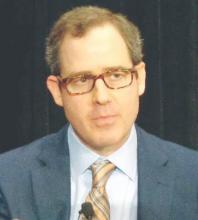LAKE BUENA VISTA, FLA. – Innovation in the design of spinal cord stimulators for control of chronic pain syndromes includes wireless devices to eliminate surgical implantation of the battery and devices with high frequency conduction to reduce paresthesias, according to an update at the Pain Care for Primary Care meeting.
“Paresthesias have been poorly tolerated by some patients, but this effect was not observed in a trial with high frequency stimulation,” explained Paul J. Cristo, MD, of the department of anesthesiology and critical care medicine, Johns Hopkins University, Baltimore.
Spinal cord stimulation for chronic pain control is not a new concept. The first device received Food and Drug Administration approval in 1989. Typically, these devices involve implantation of electrodes in the epidural space to deliver a low level of electricity that for many, but not all, individuals alleviates pain. With traditional devices, a battery and programmable generator is implanted in the buttock or abdomen to supply impulses.
Innovations since their introduction have included incremental reductions in the size of the generator and battery, facilitating implantation, and batteries that function longer or can be recharged. Some batteries now deliver stimulation for 10 or more years before they must be surgically replaced. In addition, several manufacturers now market devices that do not interfere with MRI.
The mechanism by which these devices relieve pain remains incompletely understood, according to Dr. Cristo. He cited animal studies that support several mechanisms, such as stimulation of A alpha and A beta afferent fibers to interrupt pain signals and release of serotonin and norepinephrine to inhibit pain transmission.
High-frequency stimulation
Up until last year, all devices provided neurostimulation through low frequency pulses. One of the major adverse effects has been a tingling sensation that some patients tolerate poorly. The first device to deliver high frequency pulses was approved by the FDA last year. According to Dr. Cristo, the advantage of high frequency energy is that it eliminates the risk of paresthesias.
In the registration trial with the high frequency device, which is now marketed under the name Senza by the Nevro Company, 198 chronic pain patients were randomized to an experimental or traditional device (Anesthesiology. 2015 Oct;123[4]:851-60). With the novel device, the spinal cord stimulation was delivered at a frequency of 10 kHz. Conventional spinal stimulators operate at frequencies of less than 100 Hz.
At 3 months, the proportion of patients classified as responders was greater for both back pain (84.5% vs. 43.8%) and leg pain (83.1% vs. 55.5%) when the novel and traditional devices were compared, but paresthesias, which were commonly reported on the traditional device, were not reported at all with the high frequency device.
Wireless stimulators
Wireless spinal stimulators are another relatively recent innovation with the potential to expand the proportion of chronic pain patients who may benefit from these devices. The first such device, marketed by Stimwave under the brand name Freedom SCS System, with a sister device for peripheral nerve stimulation called the StimQ PNS System, still requires implantation of a wire to deliver electrical stimulation, but the power source is external.
“The patient wears a belt that is equipped with a wireless programming device,” Dr. Cristo explained. He suggested that some may find the belt cumbersome, but a less invasive procedure is particularly attractive for patients with multiple comorbidities that make them poor candidates for device implantation.
Candidates for spinal cord stimulation are typically offered a trial to gauge response and tolerability before the device is implanted, according to Dr. Cristo. He said that pain relief of 50% or greater is generally considered a criterion for long-term benefit, but clinicians should also consider favorable effects on other outcomes, such as quality of sleep or mood.
“For some patients who do not respond to first-line options, spinal cord stimulation can substantially reduce pain levels,” Dr. Cristo said. “I use these in my own practice most commonly for failed back pain syndrome, pelvic pain, and complex regional pain syndromes.”
Although spinal cord stimulation is not first-line, Dr. Cristo also cautioned that success appears to be better when this treatment is initiated within a reasonable time frame after chronic pain has been diagnosed.
“Specifically, there is an 85% success rate if the pain has been diagnosed within 2 years. If we wait more than 15 years after the chronic pain has been diagnosed, the success rate drops to 8%,” reported Dr. Cristo, citing a published analysis.
For primary care physicians with chronic pain patients, Dr. Cristo said, “I think they should be aware of this option, because it can be effective, but they should also be aware of the time frame in which it is most likely to offer relief.”


